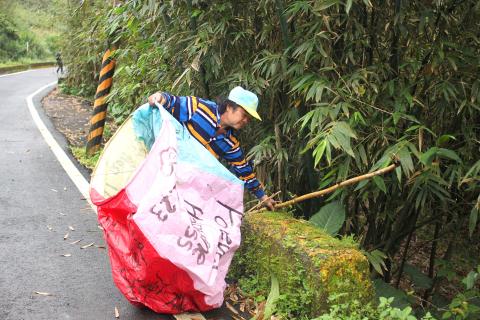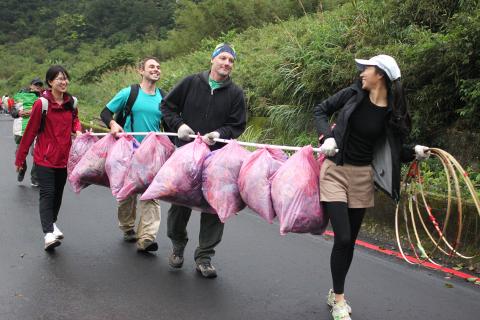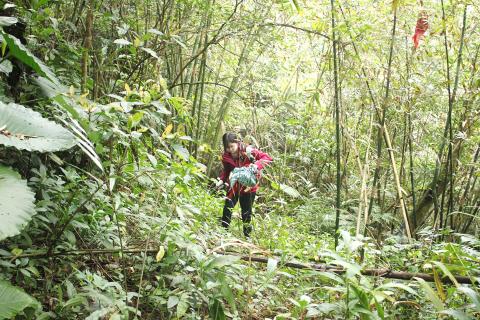An afternoon picking up fallen sky lanterns in New Taipei City's Pingsi District (平溪) with volunteers organized by Taiwan Adventure Outings, an outdoor education company, is a Sisyphean task that I won’t soon forget.
As we fill up trash bag after trash bag on the ground, the overcast sky reveals a continuing parade of lanterns making their inevitable descent.
The 21st Pingsi Sky Lantern Festival had just taken place over two days on Feb. 16 and Feb. 19, the latter being the 15th day of the Lunar New Year, which families traditionally commemorate by carrying lanterns and solving lantern riddles.
.jpg)
Photo: Davina Tham, Taipei Times
The sky lantern as an emblem of Chinese culture, coupled with an inexpensive price tag starting at NT$100, makes for a potent tourist attraction that the New Taipei City Government encourages as a must-do activity. The most popular and picturesque location from which to release a sky lantern is the train track along Shifen Old Street (十分老街).
WHERE DO LANTERNS GO WHEN THEY DIE?
So on a gray Saturday morning, I woke early and endured a whiplashing, almost hour-long, standing room-only bus ride on winding hillside roads from Taipei, to answer a question about which I have long wondered: What happens to sky lanterns when they fall?

Photo: Davina Tham, Taipei Times
My initial theories are sophisticated, because they accommodate naive optimism. Maybe lanterns rise high enough to burn up in the Earth’s atmosphere, so the ashes can float down and replenish nutrients in the soil. Maybe lantern manufacturers these days use 100 percent biodegradable materials. Maybe lanterns make landfall within a known radius of the train tracks, and cleaners are dispatched to locate and dispose of them swiftly.
There is a bit of truth in each hypothesis, but not enough.
Some lanterns burn up when their internal flames catch the combustible lining, but others fall to the ground intact. Some lantern parts are made of biodegradable paper and bamboo, but the paper is painted and treated with chemicals, and can take months to disintegrate. Everyone can certainly see where the lanterns fall, but city authorities and cleaners do not always have the resources to clear them, especially from less accessible locations.

Photo: Davina Tham, Taipei Times
When sky lanterns fall, they fall randomly, with no regard for the best of human intentions that have been written on their paper skins. They indiscriminately pepper hillsides and river banks, invade backyards and impale themselves on trees.
“The ink on this one isn’t even dry,” joked a fellow volunteer, as we picked up a pristine lantern. The tragicomedic quality of her words is striking. While besotted couples and excitable children penned heartfelt wishes on their sky lanterns, just a few kilometers and minutes away, we found them muddied on the ground, stuffing them unceremoniously into our trash bags. What a bleak metaphor for the futility of human aspirations.
One lantern had fallen squarely on a fish-shaped waterspout in a garden pond, smothering it. Another lantern descended with a flourish onto a tree branch right before us. Its red paper skin glowed, fleshlike, then tore away in charred black tatters. Within seconds, it had been reduced to a bamboo and metal skeleton.

Photo: Davina Tham, Taipei Times
Elderly residents collect the undamaged frames, each of which can be resold to the government-run recycling center for NT$8. It’s the rare environmentally-friendly practice that has stuck, because it makes business sense for the locals.
ENVIRONMENTAL OUTCRY
After years of outcry by environmental groups, the New Taipei City Government has made some attempts to address the environmental costs of the sky lanterns, such as introducing monetary incentives for recycling. But it still bows to the tourism imperative. It is difficult to do otherwise, since sky lanterns support the livelihoods of local shopkeepers, innkeepers, train and bus operators and recycling vigilantes, to name a few.
As with previous years, the city authorities organized their own official sky lantern clean-up on Feb. 24. About 200 people participated. Ironically, the event included a miniature sky lantern decoration segment, as if to whet participants’ appetite for the real thing.
Some concerned citizens are taking matters into their own hands. In 2016, a local start-up, The Culture Bank, made the news for designing lanterns using rice paper, which is readily biodegradable and dissolves in the rain. But higher costs and a stubborn adherence to tradition mean that their lanterns have yet to break into the market.
In the absence of upstream improvements, there continues to be a need for downstream fixes like volunteer clean-ups. In two hours, our band of 25 volunteers picked up 326.15kg of trash. The haul was not limited to lanterns, but also included cigarette packs and recyclable drink bottles and cans.
Despite the Sisyphean effort, there is a sense of achievement knowing that an afternoon of physical labor using the basic functions of my limbs has made a tangible contribution to the environment. It’s enough to make me think I could do it again.
■ On May 25, the 3rd annual Taiwan National Clean-Up Day organized by Taiwan Adventure Outings will take place in 20 locations across the island. To find out about participation or sponsorship opportunities, contact Ryan Hevern at ryan@taoutings.com or (0963) 520-946 and visit: www.facebook.com/groups/TaiwanAdventureOutings/.

In the March 9 edition of the Taipei Times a piece by Ninon Godefroy ran with the headine “The quiet, gentle rhythm of Taiwan.” It started with the line “Taiwan is a small, humble place. There is no Eiffel Tower, no pyramids — no singular attraction that draws the world’s attention.” I laughed out loud at that. This was out of no disrespect for the author or the piece, which made some interesting analogies and good points about how both Din Tai Fung’s and Taiwan Semiconductor Manufacturing Co’s (TSMC, 台積電) meticulous attention to detail and quality are not quite up to

April 21 to April 27 Hsieh Er’s (謝娥) political fortunes were rising fast after she got out of jail and joined the Chinese Nationalist Party (KMT) in December 1945. Not only did she hold key positions in various committees, she was elected the only woman on the Taipei City Council and headed to Nanjing in 1946 as the sole Taiwanese female representative to the National Constituent Assembly. With the support of first lady Soong May-ling (宋美齡), she started the Taipei Women’s Association and Taiwan Provincial Women’s Association, where she

Chinese Nationalist Party (KMT) Chairman Eric Chu (朱立倫) hatched a bold plan to charge forward and seize the initiative when he held a protest in front of the Taipei City Prosecutors’ Office. Though risky, because illegal, its success would help tackle at least six problems facing both himself and the KMT. What he did not see coming was Taipei Mayor Chiang Wan-an (將萬安) tripping him up out of the gate. In spite of Chu being the most consequential and successful KMT chairman since the early 2010s — arguably saving the party from financial ruin and restoring its electoral viability —

It is one of the more remarkable facts of Taiwan history that it was never occupied or claimed by any of the numerous kingdoms of southern China — Han or otherwise — that lay just across the water from it. None of their brilliant ministers ever discovered that Taiwan was a “core interest” of the state whose annexation was “inevitable.” As Paul Kua notes in an excellent monograph laying out how the Portuguese gave Taiwan the name “Formosa,” the first Europeans to express an interest in occupying Taiwan were the Spanish. Tonio Andrade in his seminal work, How Taiwan Became Chinese,